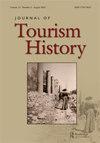伊朗旅游业的黄金时代:巴列维后期旅游业的发展(约1960-1979年)
IF 0.9
Q4 HOSPITALITY, LEISURE, SPORT & TOURISM
引用次数: 0
摘要
本文考察了1979年革命前20年伊朗旅游业的发展。在此期间,每年访问伊朗的游客人数从1962年的不到8万人增加到1977年的近70万人,因此,旅游业成为伊朗经济中越来越重要的部门。本文评估了促成该行业增长的因素,并调查了这种增长在多大程度上是政府组织(特别是Sāzmān-e Jalb-e Sayyāhān(旅游组织)、Plan组织和伊朗航空公司)制定的政策的直接结果。由于伊朗的旅游业在20世纪60年代非常不发达,伊朗旅游规划者的主要任务之一是向世界推销伊朗作为一个有吸引力的旅游目的地。这篇文章评估了政府为吸引游客而采用的各种广告策略,特别是来自利润更丰厚的欧洲和美国市场的游客。它利用了波斯语和英语的各种主要来源,最重要的是三卷Asnādi az San - at-e Jahāngardi dar Irān(伊朗旅游业文件),其中包含了从1922年到1978年伊朗旅游业的丰富材料。本文章由计算机程序翻译,如有差异,请以英文原文为准。
Iran’s golden age of tourism: the development of the travel industry in the late Pahlavi period (c. 1960-1979)
ABSTRACT This article examines the development of Iran’s tourism sector in the two decades before the revolution of 1979. In this period, the number of tourists visiting Iran each year grew from fewer than 80,000 in 1962 to nearly 700,000 by 1977, and as a result, tourism became an increasingly important sector of Iran’s economy. The article assesses the factors that contributed to the growth of the industry and investigates the extent to which this growth was the direct result of policies enacted by governmental organisations, in particular the Sāzmān-e Jalb-e Sayyāhān (Tourist Organisation), the Plan Organisation and Iran Air. Because Iran’s tourism industry was so underdeveloped in the 1960s, one of the primary tasks of Iran’s tourism planners was to market Iran around the world as an attractive tourist destination. The article evaluates the various advertisement strategies the government employed to attract tourists, particularly tourists from the more lucrative markets in Europe and the United States. It utilises a variety of primary sources in Persian and English, most importantly the three-volume Asnādi az Sanʿat-e Jahāngardi dar Irān (Documents on the Tourism Industry in Iran), which contains a wealth of material on tourism in Iran from 1922 until 1978.
求助全文
通过发布文献求助,成功后即可免费获取论文全文。
去求助
来源期刊

Journal of Tourism History
HOSPITALITY, LEISURE, SPORT & TOURISM-
CiteScore
0.60
自引率
0.00%
发文量
16
期刊介绍:
The Journal of Tourism History is the primary venue for peer-reviewed scholarship covering all aspects of the evolution of tourism from earliest times to the postwar world. Articles address all regions of the globe and often adopt interdisciplinary approaches for exploring the past. The Journal of Tourism History is particularly (though not exclusively) interested in promoting the study of areas and subjects underrepresented in current scholarship, work for example examining the history of tourism in Asia and Africa, as well as developments that took place before the nineteenth century. In addition to peer-reviewed articles, Journal of Tourism History also features short articles about particularly useful archival collections, book reviews, review essays, and round table discussions that explore developing areas of tourism scholarship. The Editorial Board hopes that these additions will prompt further exploration of issues such as the vectors along which tourism spread, the evolution of specific types of ‘niche’ tourism, and the intersections of tourism history with the environment, medicine, politics, and more.
 求助内容:
求助内容: 应助结果提醒方式:
应助结果提醒方式:


